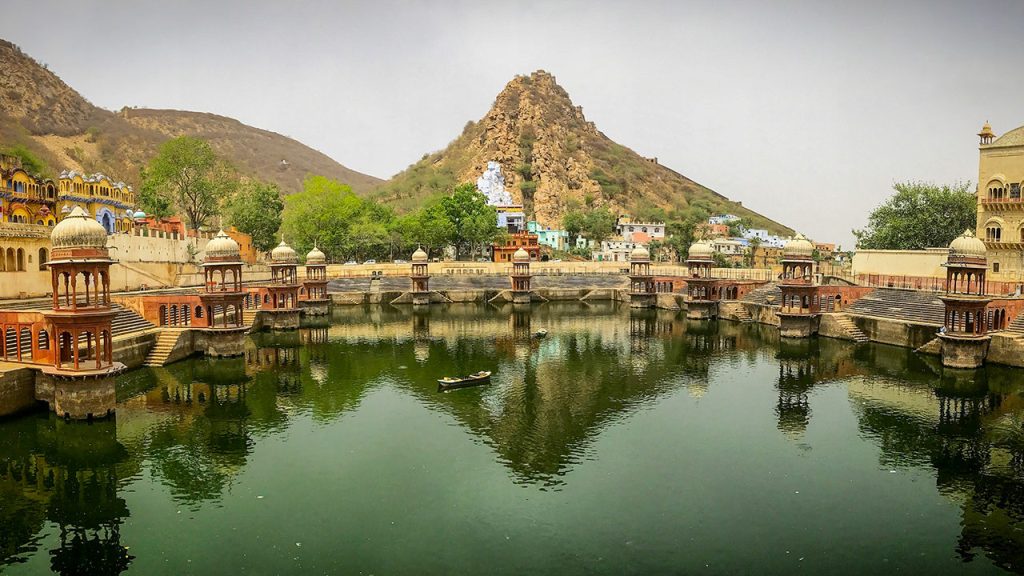Alwar, often referred to as the Gateway to Rajasthan, is a city brimming with history, culture, and natural beauty. Located in the northeastern part of India, Alwar has earned its reputation as a prominent tourist destination. In this article, we’ll delve into the myriad facets of this charming city, offering you insights, tips, and recommendations for an unforgettable visit.
Alwar has a long and rich history, dating back to the ancient times. The city is believed to have existed during the time of the Mahabharata, and was known as Matsya Desh (Land of Fish).
A Glimpse into Alwar’s History
The history of Alwar is marked by various dynasties, including the Rajputs, Mughals, and Marathas. The city has witnessed several battles and conquests, each leaving an indelible mark on its culture and heritage.
In the 11th century, Alwar was ruled by the Meo Rajputs. In the 14th century, the city was captured by the Delhi Sultanate. In the 16th century, Alwar became part of the Mughal Empire.
The city is adorned with architectural gems such as the Bala Quila, City Palace, and Neemrana Fort, each of which narrates its own story. These grand structures offer a glimpse into the opulence of the bygone era.
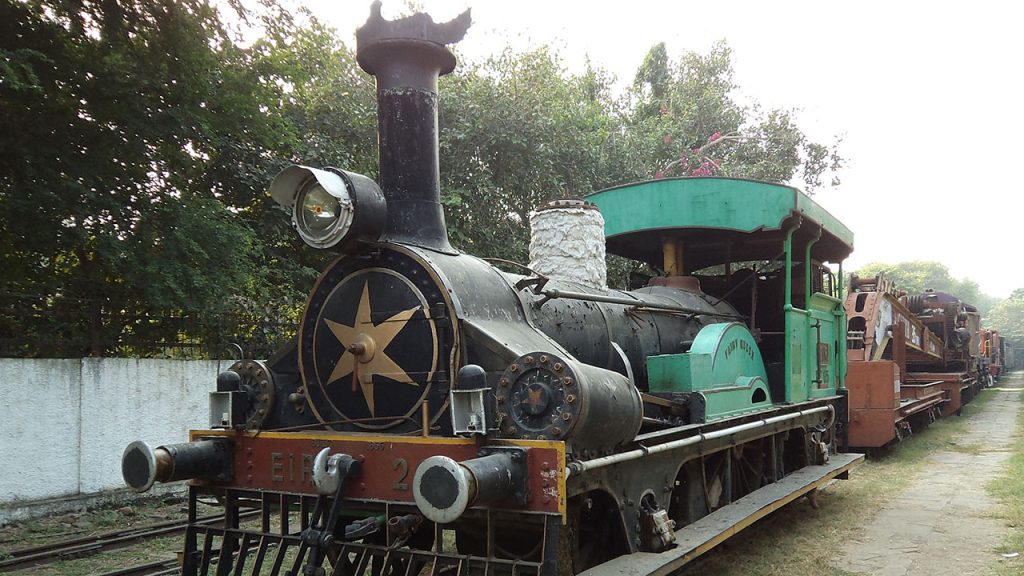
places to visit in Alwar
When in Alwar, there is no shortage of captivating places to explore. Let’s take a tour of the city’s most iconic landmarks.
Fairy Queen
The Fairy Queen is the world’s oldest working steam locomotive. It was built in 1855 by Kitson, Thompson, and Hewitson in Leeds, England, and was originally used to haul mail trains in West Bengal. The train was named after Queen Victoria, who was the reigning British monarch at the time.
In 1997, the Fairy Queen was restored to its former glory and began operating as a heritage train between Delhi and Alwar in Rajasthan. The journey takes approximately five hours, and passengers can enjoy the scenic views of the countryside as the train chugs along.
When the Fairy Queen arrives in Alwar, passengers are taken to Sariska National Park, where they can go on a jeep safari and try to spot tigers, leopards, and other wildlife. In the evening, there is a cultural program and dinner at the Sariska Palace Hotel.
The next morning, passengers are taken back to Delhi on the Fairy Queen. The train journey is a truly unique experience, and it is a great way to learn about the history of India and its railways.
The Fairy Queen train operates on a seasonal basis, from October to February. You can book tickets directly from the website or through a travel agent. It is important to book your tickets well in advance, as the Fairy Queen is a popular train and tickets tend to sell out quickly.
Bala Qila
Bala Qila, also known as Alwar Fort, is a magnificent hill fort located in the city of Alwar. It is one of the oldest forts in Rajasthan and has been passed through the hands of many dynasties, including the Yadavas, Marathas, and Kachwaha Rajputs.
The fort was originally built by Hasan Khan Mewati, the Rajput ruler of Mewat, in the 15th century. It was later captured by the Mughals and ruled by them for several years. In the 18th century, the fort was captured by the Kachwaha Rajputs, who made it their capital.
Bala Qila is a massive fort that spreads over an area of 5 kilometers from north to south and 1.6 kilometers from east to west. It is surrounded by a thick stone wall and has 15 large and 51 small towers. The fort also has six grand gates, namely Pol, Suraj Pol, Laxman Pol, Chand Pol, Krishan Pol, and Andheri Gate.
The interior of the fort is home to a number of palaces, temples, and mosques. Some of the notable structures within the fort include the Jai Prakash Mahal, the Bala Qila Mandir, and the Jama Masjid.
Bala Qila offers stunning views of the surrounding city and countryside. It is a popular tourist destination and is known for its historical significance, architectural beauty, and natural surroundings. Bala Qila is a must-visit destination for anyone interested in history, architecture, and nature. It is a beautiful and fascinating place that offers something for everyone.

Purjan Vihar
Purjan Vihar is a beautiful and aesthetic garden located in the heart of the city of Alwar, Rajasthan, India. It is also known as the Company Garden or Shimla, due to its cooler climate compared to the rest of the city. Purjan Vihar was built in 1868 AD during the reign of Maharaja Shiv Dan Singh and was originally named the Company Garden after the British East India Company. Later, Maharaja Jai Singh changed the name to Purjan Vihar, which means “garden of the people”.
Purjan Vihar is a popular tourist destination, known for its lush greenery, picturesque landscapes, and serene atmosphere. The garden is home to a variety of trees and plants, including mango, neem, peepal, and rosewood. There are also several fountains and water bodies in the garden, adding to its beauty and charm.
Purjan Vihar is a great place to relax and escape the hustle and bustle of city life. Visitors can enjoy a leisurely stroll through the garden, have a picnic under the trees, or simply sit and enjoy the peace and quiet. The garden is also a popular spot for bird watching, as it is home to a variety of bird species.
The best time to visit Purjan Vihar is during the winter months (October to March), when the weather is pleasant and cool. The garden can be visited all year round, but it is best to avoid the summer months (April to June), when the weather can be very hot and humid.

City Palace
Nestled in the foothills of the Aravalli Hills, the City Palace of Alwar is a stunning blend of Rajput and Mughal architecture. Built-in the 18th century by the Alwar Maharajas, the palace is a testament to the opulence and grandeur of the bygone era.
The palace complex is spread over a vast area and houses several palaces, courtyards, gardens, and temples. Some of the most notable attractions include:
Vinay Vilas Mahal: This beautiful palace was built by Maharaja Vinay Singh in the 19th century and is now home to a museum. The museum houses a rich collection of artifacts from the Alwar royal family, including weapons, armor, costumes, and jewelry.
Laxman Vilas Mahal: This palace was built by Maharaja Laxman Singh in the early 20th century and is known for its ornate carvings and intricate latticework.
Surya Mandir: This temple is dedicated to the Hindu sun god, Surya, and is one of the oldest temples in the palace complex.
Sheesh Mahal: This hall of mirrors is one of the most dazzling attractions in the palace. The walls and ceiling of the hall are covered in mirrors, creating a kaleidoscopic effect.
In addition to its architectural marvels, the City Palace of Alwar is also known for its lush gardens. The gardens are home to a variety of flowers, trees, and fountains, making them a perfect place to relax and soak up the beauty of the palace.
One of the most unique things about the City Palace of Alwar is its location. The palace is built on a hilltop, offering stunning views of the city and the surrounding countryside. On a clear day, you can even see the Bala Quila Fort, another iconic landmark in Alwar.
If you are ever in Alwar, be sure to visit the City Palace. It is a truly unforgettable experience to step back in time and explore this magnificent palace complex.
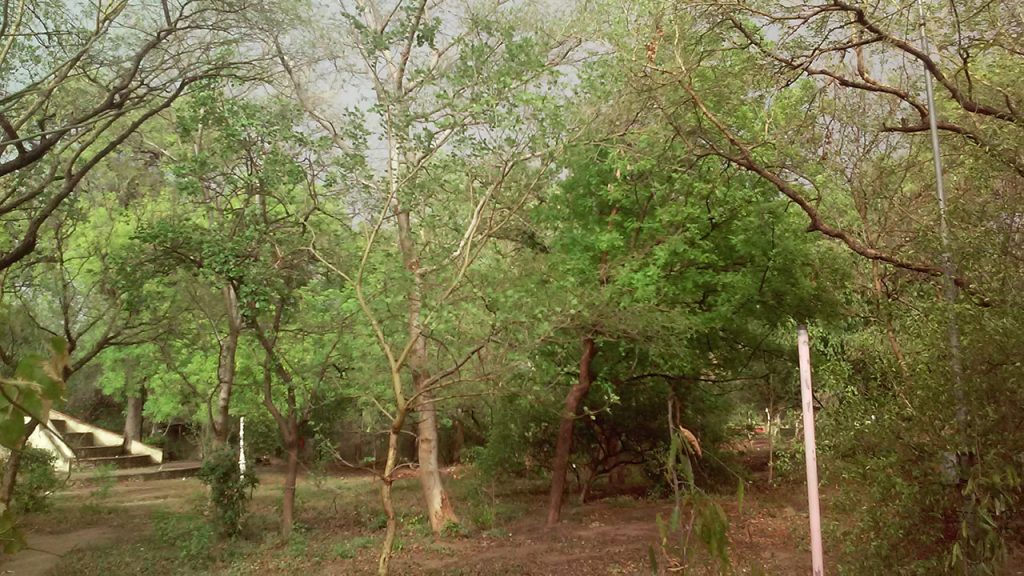
Sariska Tiger Reserve
Sariska Tiger Reserve, nestled in the rugged Aravalli hills of Alwar, Rajasthan, is a unique gem among India’s protected wildernesses. It is one of the few tiger reserves in the country where the majestic big cats can be seen roaming freely in their natural habitat.
But Sariska is more than just a tiger reserve. It is a mosaic of diverse landscapes, from lush forests to rocky outcrops to meandering rivers. This diversity is home to a rich tapestry of wildlife, including leopards, sloth bears, hyenas, jackals, various species of deer, and over 200 species of birds.
One of the things that makes Sariska unique is its history. The reserve is believed to have been a hunting ground for the Pandavas, the legendary heroes of the Mahabharata epic. It was also once home to a thriving population of tigers, but by the early 2000s, poaching had decimated the population.
Apart from its wildlife, Sariska is also home to a number of historical and cultural attractions. The Kankwadi Fort, a 17th-century Rajput fort, is a popular tourist destination. The Neelkanth Mahadev Temple, dedicated to Lord Shiva, is also located within the reserve.
Sariska is a truly unique place, where visitors can experience the magic of the Indian wilderness firsthand. Whether you are a wildlife enthusiast, a history buff, or simply looking for a place to escape the hustle and bustle of city life, Sariska is sure to captivate you.

Bhangarh Fort
Nestled in the Aravali Hills of Rajasthan, India, lies the abandoned Bhangarh Fort. Built in the 17th century by Raja Madho Singh, it was once a thriving city with over 10,000 inhabitants. But today, it stands in ruins, a testament to a dark and mysterious past.
Legend has it that Bhangarh Fort is cursed. The most popular story tells of a sadhu named Baba Balau Nath who lived in the hills overlooking the fort. When Raja Madho Singh began construction of the fort, Baba Balau Nath warned him that it should not cast a shadow on his abode. The Raja ignored his warning, and the fort was built, blocking out the sun from Baba Balau Nath’s home.
The sadhu was enraged, and he cursed the fort and its inhabitants. He prophesied that Bhangarh would soon be deserted and that its people would die a terrible death. And so it came to be. In 1720, the Mughal army attacked Bhangarh, and the entire city was massacred. Since then, the fort has been deserted, and it is said to be haunted by the spirits of the dead.
Visitors to Bhangarh Fort report a variety of strange phenomena, including hearing disembodied voices, seeing ghostly figures, and experiencing sudden temperature changes. Some even claim to have been touched or attacked by spirits.
Whether or not Bhangarh Fort is truly haunted is a matter of debate. But there is no doubt that it is a place with a dark and mysterious past. And for those who are brave enough to visit, it is an experience that is sure to stay with them long after they leave.
Beyond its reputation as a haunted place, Bhangarh Fort is also a unique and fascinating historical site. The fort is well-preserved, and its ruins offer a glimpse into the life and culture of a once-thriving city.
One of the most striking things about Bhangarh Fort is its location. The hilltop fort stands like a sentinel, surveying the picturesque countryside below. The Aravali Hills are home to a variety of wildlife, including leopards, nilgai, and peacocks. Visitors to Bhangarh Fort can often spot these animals while exploring the ruins.
Another unique aspect of Bhangarh Fort is its architecture. The fort is built in the Rajput style, which is characterized by its intricate carvings and ornate design. The fort also features a number of temples and mosques, which reflect the religious diversity of its former inhabitants.
Moti Doongri
Moti Doongri, a hilltop locality in the city of Alwar is a unique place where Hindus and Muslims come together to worship at the same shrine. The Sankat Mochan Vir Hanuman Mandir and Sayyed Darbar are located in the same complex, without any walls separating them. On Thursdays, the loudspeakers play Bhajans in the morning and Qawwali in the evening, creating a magical aura of harmony and tolerance.
The hill is also home to the ruins of the Moti Doongri Palace, built by Maharaja Mangal Singh in 1882. Within the palace, there’s a Laxminarayan Temple and a Ganesh Temple that are open to the public.
But what makes Moti Doongri truly unique is its spirit of communal amity. It is a place where people of all faiths come together to pray for peace and prosperity. It is a reminder that we are all one, despite our differences.
There is a legend associated with Moti Doongri that tells the story of how the Hindu and Muslim shrines came to be located in the same complex. Once upon a time, there was a Muslim saint named Sayyed Baba who lived on the hill. He was a wise and compassionate man who was respected by people of all faiths. One day, a Hindu temple dedicated to Lord Hanuman was built on the hilltop.
Sayyed Baba was pleased with the construction of the temple and saw it as a sign of communal harmony. He declared that the hill would be a place where people of all faiths could come together to worship.
And so, the Sankat Mochan Vir Hanuman Mandir and Sayyed Darbar came to be located in the same complex, without any walls separating them. Since then, Moti Doongri has been a symbol of unity and faith, where people of all religions come together to pray for peace and prosperity.
Today, Moti Doongri is a popular tourist destination, known for its unique religious and cultural significance. Visitors from all over India and the world come to Moti Doongri to experience its unique atmosphere of communal harmony.
The hill also offers stunning views of the city of Alwar and the surrounding countryside. Visitors can also explore the ruins of the Moti Doongri Palace and visit the Laxminarayan and Ganesh Temples.

Siliserh Lake
Nestled in the heart of the Aravalli Hills, Siliserh Lake is a picturesque oasis in the otherwise arid landscape. Built-in the 19th century by Maharaja Vinay Singh, the lake is a stunning testament to the ingenuity and craftsmanship of the bygone era.
Surrounded by lush green hills and dotted with islands, Siliserh Lake is a haven for nature lovers. The lake is home to a variety of birds, including migratory species like flamingos and pelicans. Visitors can also spot crocodiles and other aquatic animals in the lake.
One of the most unique things about Siliserh Lake is its Lake Palace, which is perched on a hilltop overlooking the lake. The palace was built by Maharaja Vinay Singh for his queen, Sheela, and it now serves as a heritage hotel. Visitors can enjoy a luxurious stay at the palace while taking in the breathtaking views of the lake and the surrounding hills.
Another unique aspect of Siliserh Lake is its annual boat race, which is held every year on the occasion of Makar Sankranti. The race is a colorful and festive event that attracts thousands of spectators from all over the country.
Whether you are looking for a relaxing getaway in the lap of nature or an adventurous vacation filled with activities, Siliserh Lake has something to offer everyone. So, if you are planning a trip to Rajasthan, be sure to add this hidden gem to your itinerary.
Another unique way to experience Siliserh Lake is to stay at the Lake Palace. The palace offers a luxurious experience with stunning views of the lake and the surrounding hills. You can enjoy a leisurely meal at the palace restaurant or simply relax on the balcony and take in the beauty of the scenery.
Hill Fort Kesroli
Perched atop a rocky hill, Hill Fort Kesroli is a majestic 14th-century fort that offers a glimpse into Rajasthan’s regal past. This unique heritage hotel is a member of the Neemrana Hotels group, which is known for its sensitive restoration and preservation of historic properties.
As you drive through the winding roads leading up to the fort, you’ll be greeted by breathtaking views of the surrounding countryside. The fort itself is a sight to behold, with its towering walls, sturdy turrets, and intricate carvings.
Upon entering the fort, you’ll be transported to another era. The narrow cobblestone streets, the lush gardens, and the charming courtyards all evoke a sense of romance and mystery.
The hotel offers a variety of accommodation options, from luxurious suites to cozy rooms with traditional Rajasthani décor. All the rooms are beautifully appointed and offer stunning views of the surrounding hills and valleys.
Hill Fort Kesroli is more than just a hotel. It’s a place where you can experience the true essence of Rajasthan. From the delicious food to the warm hospitality, everything at the fort is designed to make you feel at home.
If you’re looking for a truly unique and unforgettable travel experience, Hill Fort Kesroli is the perfect place for you. This timeless gem offers a rare opportunity to experience the best of Rajasthan’s culture, heritage, and hospitality.
Lal Masjid, Tijara
The Lal Masjid, or Red Mosque, in Tijara, Alwar, is a 17th-century mosque that is unique for a number of reasons.
It is one of the few mosques in India that is built entirely of red sandstone. This gives it a distinctive red color that is especially striking in the sunlight.
The mosque has a unique design with fluted minarets at the four corners and arched doorways. The fluted minarets are particularly noteworthy, as they are not commonly found in Indian mosques.
The mosque is home to a number of faint Arabic inscriptions, which are believed to be from the 17th century. These inscriptions are a valuable source of information about the history of the mosque and the region.
The Lal Masjid is a popular place of worship for Muslims in the area and is also a popular tourist destination. This is due to its beautiful architecture, peaceful atmosphere, and historical significance.
The Lal Masjid is a place of peace and tranquility, where visitors can come to reflect and connect with their spiritual side. It is also a place of beauty, where the red sandstone walls glow in the sunlight and the minarets dance against the azure sky.

Moosi Maharani ki Chhatri
Moosi Maharani Ki Chhatri, a cenotaph dedicated to Maharaja Bakhtawar Singh and his mistress, Moosi, is a unique architectural gem in Alwar, Rajasthan. Built in 1815 by Maharaja Vinay Singh, the cenotaph is a blend of Hindu and Mughal architectural styles, with intricate carvings and latticework.
The cenotaph was built in Moosi’s honor, and it is said that her spirit still resides there. Visitors to the cenotaph often report feeling a strange energy, and some even claim to have seen Moosi’s ghost.
Another unique aspect of Moosi Maharani Ki Chhatri is its setting. The Cenotaph is located on a hilltop overlooking the city of Alwar, and the views from the top are simply breathtaking. On a cloudless day, the horizon stretches on forever in all directions. Moosi Maharani Ki Chhatri is a must-visit for anyone interested in history, architecture, or the paranormal. It is a unique and fascinating place, with a story that is both tragic and captivating.
On a clear night, visit the cenotaph when the moon is full. The moonlight will cast a soft glow over the white marble, and the intricate carvings will come to life. As you walk through the cenotaph, take your time to admire the architecture and feel the energy of the place.
Fateh Jung Gumbad
Fateh Jung Gumbad is a unique architectural gem, nestled in the heart of the heritage city of Alwar. Built-in 1647 AD, this five-storied tomb is a testament to the fusion of Mughal and Rajput architectural styles. The tomb is dedicated to Fateh Jung, a minister and governor in the court of Mughal emperor Shah Jahan. Jung was a highly respected figure, and his tomb is a fitting tribute to his legacy.
The tomb is built on a raised platform and is surrounded by a lush green garden. The entrance to the tomb is through a grand archway, which is flanked by two tall minarets. The minarets are decorated with intricate carvings and are topped by octagonal domes.
The tomb itself is a square structure with four floors. The first floor is the largest and is where the tomb of Fateh Jung is located. The tomb is made of white marble and is decorated with intricate calligraphy. The upper floors of the tomb are smaller and are decorated with balconies and jharokhas. The fifth and final floor is topped by a large dome.
The interior of the tomb is simple but elegant. The walls are decorated with Quranic verses and geometric patterns. The tomb of Fateh Jung is located in the center of the tomb and is surrounded by a screen of white marble.
Fateh Jung Gumbad is a unique example of Indo-Islamic architecture. The tomb is a blend of Mughal and Rajput architectural elements, which can be seen in the intricate carvings, the use of white marble, and the overall design of the structure.
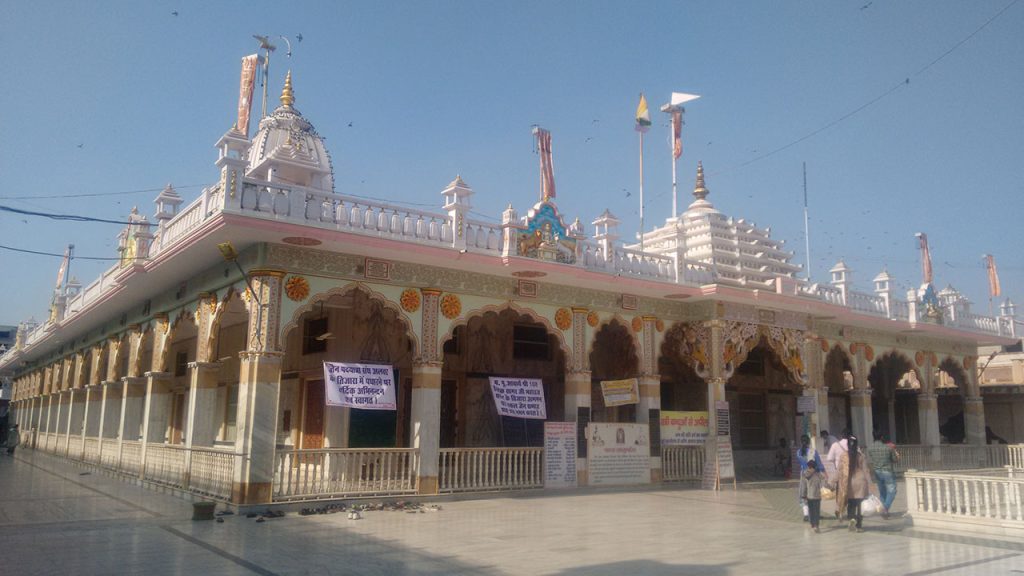
Tijara Jain Temple
Tijara Jain Temple is a captivating pilgrimage site nestled in the picturesque town of Tijara in the Alwar district, Rajasthan. Dedicated to the eighth Jain Tirthankara, Lord Chandra Prabhu, it is one of the most revered Jain temples in India.
What sets this temple apart is its unique architectural style, which blends elements of Rajput, Mughal, and Jain architecture. The sprawling temple complex houses a magnificent sanctum sanctorum, a colossal white marble statue of Lord Chandra Prabhu, and several other smaller shrines dedicated to other Jain deities.
The temple’s ornate facade is a sight to behold, with its intricate carvings and delicate latticework. The interiors are equally mesmerizing, with their gleaming marble floors, colorful murals, and exquisite sculptures.
A visit to Tijara Jain Temple is a truly immersive experience. The temple’s serene atmosphere and spiritual aura transport visitors to a realm of peace and tranquility. Devotees from all over India flock to this sacred shrine to seek blessings and offer their prayers.
Apart from its religious significance, Tijara Jain Temple is also a popular tourist destination. The temple’s architectural splendor, intricate carvings, and serene ambiance attract visitors from all over the world.
Talvraksh
Talvraksh, a small village nestled in the foothills of the Aravalli Range, is a hidden gem in the district of Alwar, Rajasthan. It is known for its lush green forests, pristine lakes, and ancient temples. The name Talvrakh literally means “tree lake”, and it is said that the village got its name from the abundance of tal trees (palm trees) that once grew here.
Talvraksh is a popular pilgrimage site for Hindus, as it is home to a revered temple dedicated to the goddess Ganga. The temple is believed to be over 1000 years old, and it is said that the goddess Ganga herself manifested herself in the form of a spring here. The temple complex also includes a hot water spring, which is believed to have medicinal properties.
In addition to its religious significance, Talvraksh is also a popular tourist destination. The village is surrounded by dense forests, which are home to a variety of wildlife, including leopards, deer, and monkeys. The village is also home to a number of lakes, which are ideal for swimming, boating, and fishing.
One of the most unique things about Talvraksh is its atmosphere of peace and tranquility. The village is far from the hustle and bustle of city life, and it is the perfect place to relax and rejuvenate. Visitors to Talvraksh can enjoy a variety of activities, such as hiking, picnicking, and birdwatching. They can also visit the local villages and learn about the traditional Rajasthani culture.
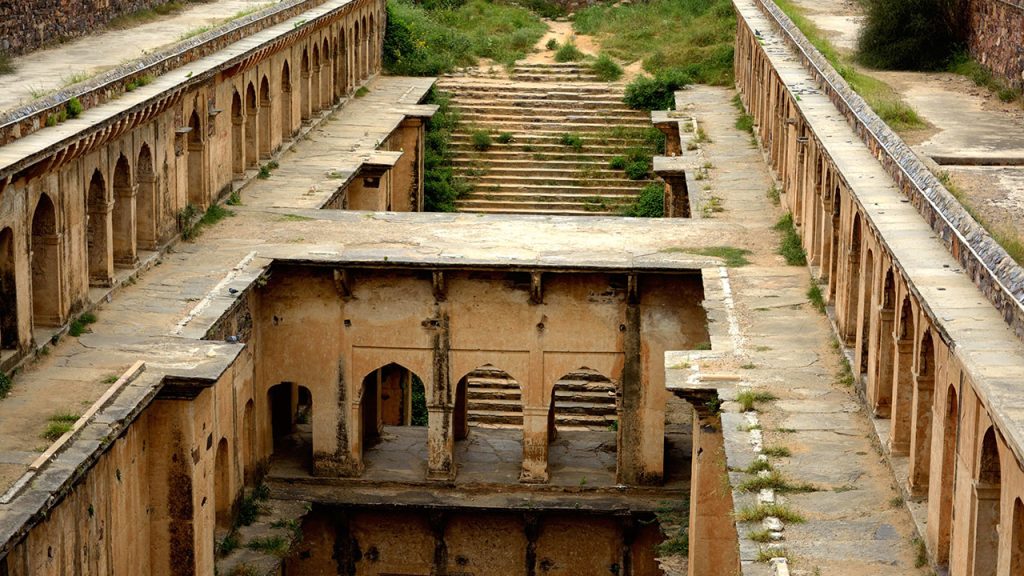
Neemrana Baori
Neemrana Baori, also known as Chand Baori, is one of the most impressive stepwells in India. It is located in the village of Neemrana, Rajasthan, about 122 kilometers from Delhi. The baori is believed to have been built in the 16th century by Raja Chand, the ruler of Alwar.
Neemrana Baori is one of the largest and deepest step-wells in India, with 13 levels and 3500 steps. The baori is 13 stories deep and 66 meters wide. The steps are arranged in a geometric pattern, and the walls are decorated with intricate carvings. The baori is a popular tourist destination, and it is also used by the locals to collect water.
One of the most unique things about Neemrana Baori is its architecture. The baori is built in a stepwell style, which means that it has a series of steps that lead down to a water reservoir. The steps are arranged in a geometric pattern, and the walls are decorated with intricate carvings. The baori is also notable for its size and depth. It is one of the largest and deepest stepwells in India, with 13 levels and 3500 steps.
Another unique thing about Neemrana Baori is its history. The baori is believed to have been built in the 16th century by Raja Chand, the ruler of Alwar. Raja Chand was a wise and benevolent ruler, and he built the baori to provide water to the people of Neemrana. The baori is a testament to the engineering skills of the ancient Indians, and it is also a reminder of the rich history of Rajasthan.
Neemrana Baori is a truly unique and special place. It is a marvel of engineering, a testament to the rich history of Rajasthan, and a popular tourist destination. If you are ever in the area, be sure to visit Neemrana Baori.
Raja Bhartrihari Panorama Alwar
Nestled in the heart of Alwar, Rajasthan, lies the Raja Bharthari Panorama, a unique museum that offers visitors a glimpse into the life and legacy of one of India’s most fascinating kings. Raja Bharthari was a 7th-century king who renounced his worldly possessions and became a sage. He is credited with writing the famous Sanskrit anthology of poems, the Satakas, which explore themes of love, life, and spirituality.
The Raja Bharthari Panorama is housed in a circular building with a central dome. The walls of the building are adorned with murals that depict the life of Raja Bharthari, from his birth and coronation to his renunciation and spiritual journey.
The museum also features a life-size statue of Raja Bharthari in a meditation pose. The statue is surrounded by a lotus pond, creating a serene and peaceful atmosphere. Visitors to the Raja Bharthari Panorama can learn about the king’s life and legacy through interactive exhibits and multimedia presentations. The museum also houses a library with a collection of books and manuscripts on Raja Bharthari and his works.

Culinary Delights of Alwar
Alwar, a city in the Indian state of Rajasthan, is known for its rich history, culture, and natural beauty. It is also home to a vibrant culinary scene, with restaurants serving a wide range of cuisines, from traditional Rajasthani to international fare.
For gourmets, Alwar is a paradise. There are many restaurants that serve delicious food made with fresh, local ingredients. Here are The A-list:
Taste Minister Restaurant & Cafe
Taste Minister is a popular restaurant that serves a variety of cuisines, including Indian, Chinese, Continental, and South Indian. The food is always fresh and flavorful, and the service is excellent. The restaurant also has a beautiful outdoor seating area, which is perfect for a romantic dinner or a meal with friends and family.
The Food CraveYard
The Food CraveYard is a newer restaurant in Alwar, but it has quickly become a favorite among locals and tourists alike. The restaurant serves a variety of North Indian and Mughlai dishes, all of which are made with authentic recipes and fresh ingredients. The Food CraveYard is also known for its beautiful ambiance and excellent service.
Paradise Garden
Paradise Garden is a fast-food restaurant that serves a variety of Indian and international dishes. The food is always delicious and affordable, and the restaurant is a great place to go for a quick and casual meal.
In addition to these restaurants, Alwar is also home to a number of street food stalls that serve delicious and authentic Rajasthani snacks and dishes. Be sure to try the following:

Pyaaz Kachori: A savory dance of onions and spices, encased in a delicate crust.
Mirchi Bada: A deep-fried chili pepper stuffed with a potato filling.
Dal Bati Churma: A traditional Rajasthani dish consisting of lentils, dumplings, and crushed wheat.
Ghewar: A sweet dish made with flour and sugar syrup.
Kalakand – Kalakand is a popular Indian sweet made from milk. A velvety embrace with a hint of grit, infused with the warm kiss of cardamom.
No matter what your budget or taste, you are sure to find something to your liking in Alwar. So come and experience the city’s vibrant culinary scene for yourself!
Here is a unique way to experience Alwar’s culinary scene:
Enjoy a hands-on cooking experience with a local insider. This is a great way to learn about the traditional Rajasthani cuisine and to try some of the most popular dishes. You will also get to experience the warmth and hospitality of the Rajasthani people.
Once you have learned how to make some of your favorite Rajasthani dishes, you can take your newfound cooking skills home with you and impress your friends and family. So what are you waiting for? Book a private cooking class today and start your culinary journey in Alwar!
How to reach Alwar
Alwar is a city in the Indian state of Rajasthan, located about 160 km from the state capital of Jaipur. The city is well-positioned to connect with other major cities in India, with a comprehensive transportation system that includes road, rail, and air travel.
By road
The best way to reach Alwar from Udaipur is by taxi. The journey takes approximately 8-9 hours. There are a number of taxi services in Udaipur that offer rides to Alwar. Some of the best taxi services in Udaipur include:
- CabBazar
- Ola
- Uber
- MakeMyTrip
- Yatra
You can also book a taxi through a tour operator in Udaipur. Some of the best tour operators in Udaipur include:
- Rajasthan Tourism Development Corporation (RTDC)
- Thomas Cook
- Cox & Kings
- MakeMyTrip
- Yatra
By Train
There are a number of trains that run from Udaipur to Alwar. The journey takes approximately 10-12 hours. Whether you prefer the convenience of online booking or the personal touch of a railway station counter, there’s a way to reserve your train tickets.
By air
There is no direct flight from Udaipur to Alwar. The nearest airport to Alwar is Jaipur International Airport, which is located about 160 km away. You can take a taxi or bus from Jaipur to Alwar.
FAQs about Alwar
What is the best time to visit Alwar?
The ideal time to visit Alwar is during the winter months, from October to March when the weather is pleasant for sightseeing.
Is Alwar safe for tourists?
Yes, Alwar is generally safe for tourists. However, it’s advisable to take basic precautions and follow local guidelines.
Are there any adventure activities in Alwar?
Yes, Alwar offers adventure activities such as zip-lining, trekking, and jeep safaris in the Aravalli hills.
Can I explore Alwar on a budget?
Absolutely, Alwar has options for budget travelers, including affordable accommodations and local street food.
What are the must-buy souvenirs from Alwar?
Some popular souvenirs to buy from Alwar include traditional Rajasthani handicrafts, jewelry, and miniature paintings.
How can I reach Alwar?
Alwar is well-connected by road and rail, and the nearest airport is in Jaipur, about 150 kilometers away.
Conclusion
Alwar, a city steeped in history and natural beauty, is a destination that offers an enchanting experience for travelers. Its historical sites, culinary delights, and serene landscapes make it a must-visit location in Rajasthan. So, pack your bags and explore the wonders of Alwar, the city of legends.

